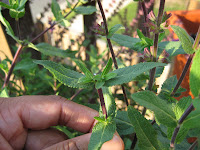 That's according to the Travel and Tourism Board. Whether it's true or not is a topic for debate but one thing I can tell you is Virginia is definitely for Gardeners. By my count, three out of every five Virginians are sporting a green thumb. The remaining two have the makings for one, even if they don't yet know it. That's where I come in because I think anyone can put together a simple, attractive garden in a container and keep it alive all season long without much effort.
That's according to the Travel and Tourism Board. Whether it's true or not is a topic for debate but one thing I can tell you is Virginia is definitely for Gardeners. By my count, three out of every five Virginians are sporting a green thumb. The remaining two have the makings for one, even if they don't yet know it. That's where I come in because I think anyone can put together a simple, attractive garden in a container and keep it alive all season long without much effort.So for my friends and neighbors here in Virginia who are ready to release their inner gardener and have asked me where to go to get started, I have a few places to recommend:
Merrifield Garden Center: I shudder to think of what the final amount would be if I were to tally up all of my receipts over the years. Merrifield has managed to round up some of the smartest gardening folks I've ever come across. And what's even better is that they are always so eager to help experienced and novice gardeners alike. Their enthusiasm never wanes. Although they have a website, nothing can equal a personal visit to one of the three stores. I'm loyal to the one in Fairfax because it is just huge. If they don't have the plant, pot, tool or gardening product you're looking for, my guess is, you just don't need it.
Big box stores: Some of the more accomplished gardeners I know are quick to dismiss the big box stores. There was a time when that snobbery might have been legitimate. But believe me, Home Depot and Lowe's are not stupid. They have seen how the gardening industry has exploded in recent years and they have been particularly responsive to the increasing number of people who have developed an interest in container gardening. Now I will say that I've noticed they don't quite give their plants the same tender, loving care that you might find at a local nursery so midway through the season you are liable to see some pretty sad looking specimens. My advice is always to shop carefully no matter where you plan to spend your money. And if you want lightweight, fantastic looking faux terra cotta planters and aged urns, the selection has improved dramatically in recent years.
Target: Most folks have a store nearby and it is a great place to pick up some gardening supplies and containers--especially if you are new to gardening. I say this because it won't cost you an arm and a leg so you can tiptoe into the gardening waters to see if you like them (you will, I promise). After that, you can graduate to the fancier supplies if you wish. There's also a great selection of planters and containers in the store and on the website.
Depending on where you live, you might have a small local nursery near your neighborhood. It may be a permanent store or a temporary structure. For example, there is a huge tent that sets up in the parking lot near our local Whole Foods store in Springfield. The vendor is called GardenMasters and has no affiliation (that I know of) to Whole Foods. It is really a good sized operation for being temporary and they open up shop in mid-April and close in late June every year. It has a remarkable selection and I do quite a bit of shopping there. Driving around various parts of Northern Virginia, I see similar vendors everywhere though sometimes they may be in a parking lot near a school. Definitely check them out and if it's a temporary location, find out when they are going to close up shop because during the days leading up to that is when they start slashing prices.
Bookshelf: Container Gardening Books
















